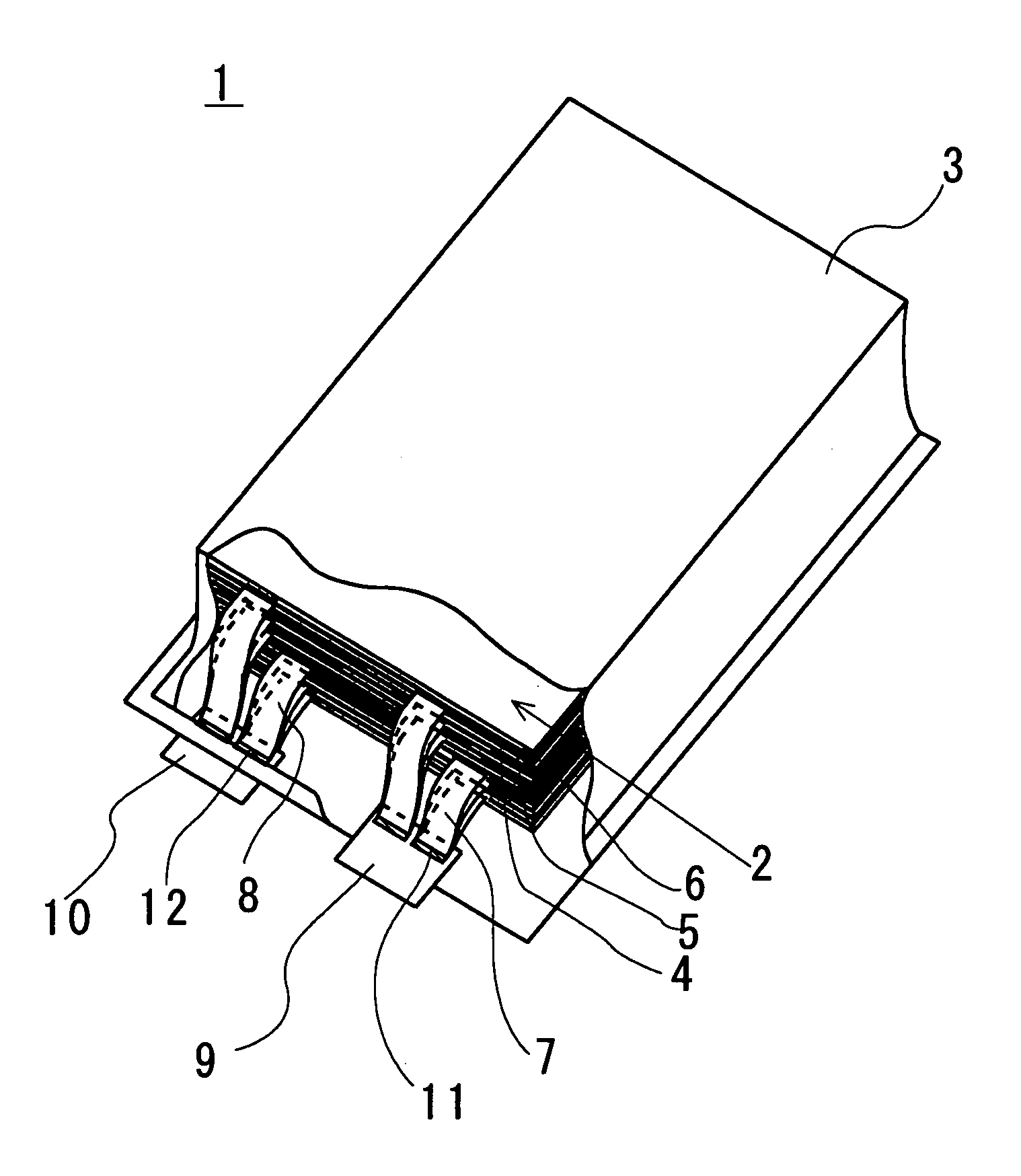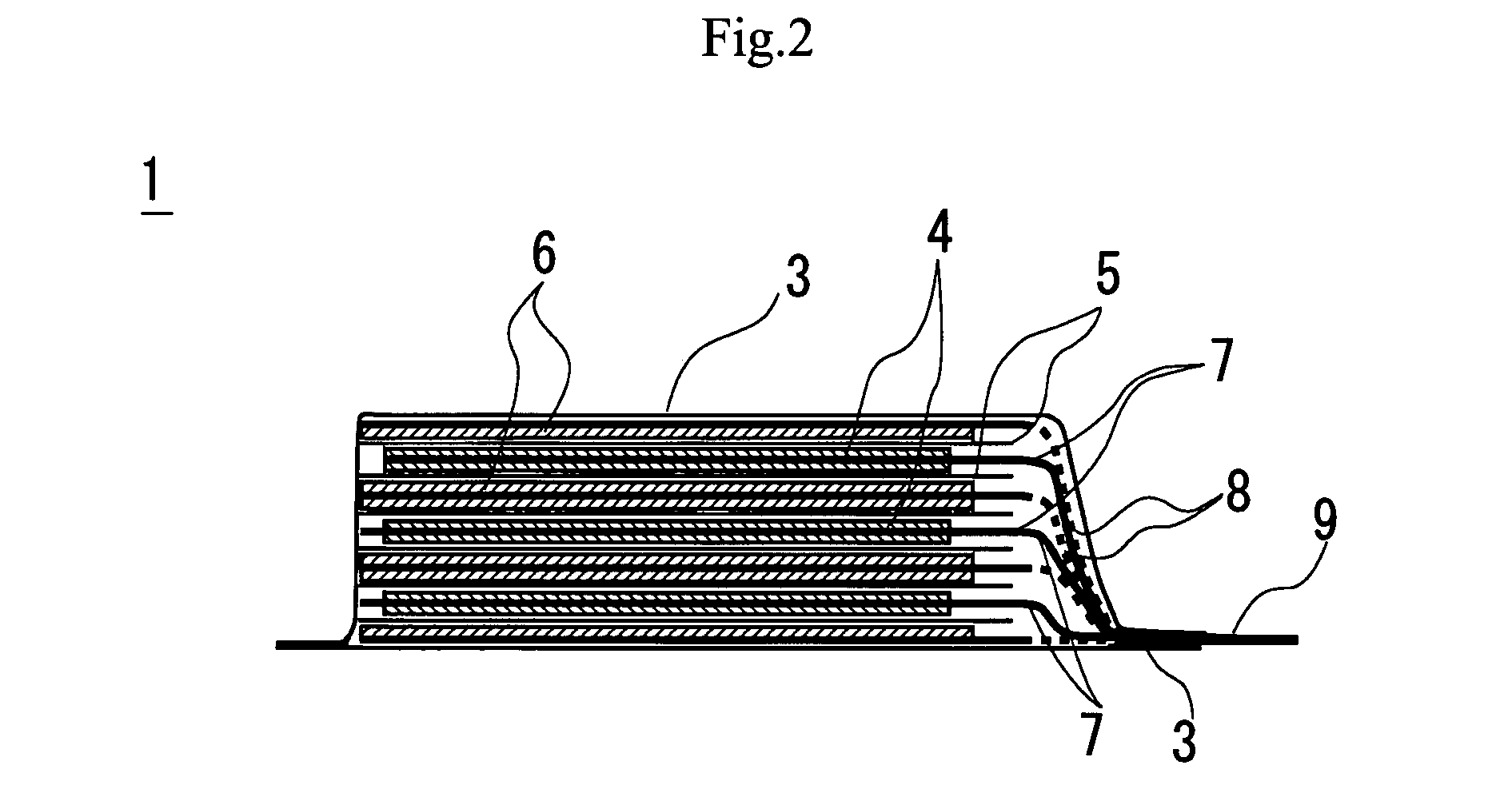Method for production of stacked battery
a technology of stacked batteries and stacked plates, which is applied in the direction of cell components, final product manufacturing, sustainable manufacturing/processing, etc., can solve the problems of high probability of cutting and breaking of endmost current collection tabs in welding process, high welding strength, and high probability of cutting and breaking of endmost current collection tabs. , to achieve the effect of increasing the number of current collection tabs and stably welding
- Summary
- Abstract
- Description
- Claims
- Application Information
AI Technical Summary
Benefits of technology
Problems solved by technology
Method used
Image
Examples
first embodiment
[0050]FIG. 1 is a partly cut out schematic perspective view of a stacked battery according to the present invention. The stacked member of the stacked battery is illustrated in detail in FIG. 3B.
[0051]The stacked battery 1 is formed by covering the stacked member 2 formed by laying positive electrodes 4 and negative electrodes one on the other with separators 5 interposed between them with a flexible film casing 3. In the stacked battery 1, the positive electrode current collection tabs 7 that are bonded to the positive electrodes 4 are connected to the positive electrode lead terminal 9 at the junction 11.
[0052]Similarly, the negative electrode current collection tabs 8 that are bonded to the negative electrodes 6 are connected to the welding section 12 of the negative electrode lead terminal 10 and thermally welded to and sealed by the flexible film casing 3.
[0053]In the following description, it is assumed that a stacked battery according to the invention is a stacked lithium-ion...
second embodiment
[0064]FIG. 4 is a schematic perspective view of part of a stacked battery according to the present invention after welding the positive electrode current collection tabs and the positive electrode lead terminals.
[0065]When positive electrodes 4 and negative electrode 6 are laid one on the other with separators 5 interposed between them to form a stacked member 2, the positive electrode current collection tabs are arranged in such a way that the positive electrode current collection tabs 7 can be divided into first group of positive electrode current collection tabs 7A, second group of positive electrode current collection tabs 7B and third group of positive electrode current collection tabs 7C and any two adjacently located two groups can be separated from each other by a gap in a direction orthogonal relative to the direction in which the positive electrode current collection tabs 7 are taken out.
[0066]Then, the first group of positive electrode current collection tabs 7A, the seco...
third embodiment
[0068]FIG. 5 is a schematic perspective view of part of a stacked battery according to the present invention after welding the current collection tabs and the lead terminals.
[0069]The positive electrode current collection tabs are divided into groups in the direction in which the positive electrodes of the stacked member are laid in the first embodiment.
[0070]On the other hand, in the third embodiment, every other positive electrode current collection tab is, in other words the second, the fourth and the sixth positive electrode current collection tabs 7 are, taken and laid one on the other to form the first group of positive electrode current collection tabs 7A. Similarly, the first, the third and the fifth positive electrode current collection tabs 7 are taken and laid one on the other to form the second group of positive electrode current collection tabs 7B.
[0071]The positions for drawing out the positive electrode current collection tabs 7 are not lopsided and uniformly distribu...
PUM
| Property | Measurement | Unit |
|---|---|---|
| current | aaaaa | aaaaa |
| current | aaaaa | aaaaa |
| current | aaaaa | aaaaa |
Abstract
Description
Claims
Application Information
 Login to View More
Login to View More - R&D
- Intellectual Property
- Life Sciences
- Materials
- Tech Scout
- Unparalleled Data Quality
- Higher Quality Content
- 60% Fewer Hallucinations
Browse by: Latest US Patents, China's latest patents, Technical Efficacy Thesaurus, Application Domain, Technology Topic, Popular Technical Reports.
© 2025 PatSnap. All rights reserved.Legal|Privacy policy|Modern Slavery Act Transparency Statement|Sitemap|About US| Contact US: help@patsnap.com



